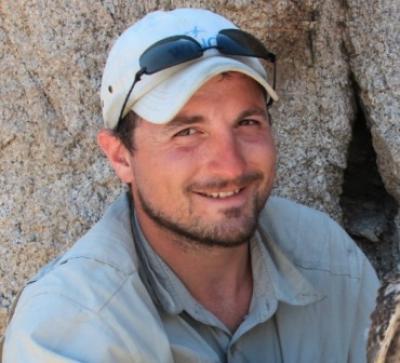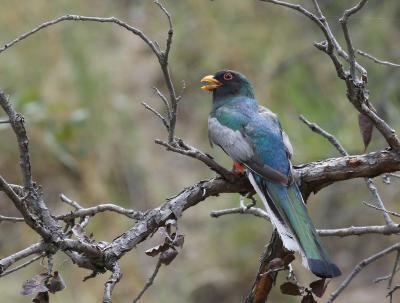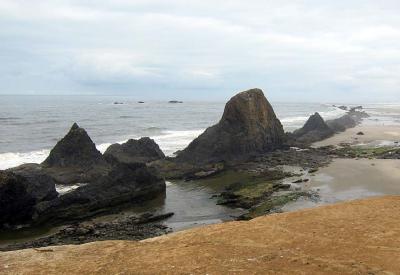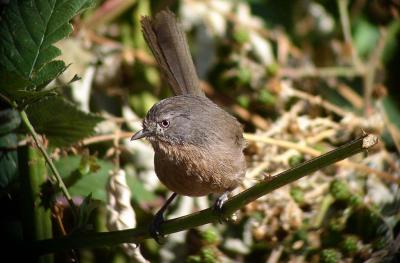Alaska: Fall Migration at Gambell & Nome
-
Aug 28 to Sep 6 2026
Jake Mohlmann
Tour Price to be Determined
Tour Price to be Determined
Birding on the Bering Sea outposts during the early autumn offers a variety of western Alaska specialties, an incredible seabird spectacle, southbound shorebirds that include small numbers of Old World species, and a good chance of finding Asian landbird strays. This revamped tour is scheduled to take in both Nome, with its fall foliage and mainland specialties such as Arctic Loon, Willow Ptarmigan, Gyrfalcon, and Bar-tailed Godwit, as well as Gambell, with its vegetated boneyards and remote appeal. In contrast to the spring migration period, fall migration is protracted and full of glorious uncertainty, but some of the plumages, to say nothing of the species, are rarely seen on North American birding tours. Although rare passerines can be expected to occur between late August and early October, the number, composition, and timing of their occurrence vary from year to year, depending on such factors as the weather, that year’s nesting success, and of course good luck!
We’ve timed the Gambell portion of the tour to coincide with the movement of trans-Beringian migrants heading back to their Old World wintering grounds. Usually, we detect numbers of Arctic Warblers, Eastern Yellow Wagtails, Northern Wheatears, Bluethroats, and Red-throated Pipits heading west. Here too a multitude of alcids will be present in sometimes mind-numbing numbers, and the seawatching from the point is perhaps unsurpassed in North America.
*It is possible to skip the Nome days. Please let the tour manager know if this is of interest.
** Note if you wish to spend more time at Gambell, we've added an option of extending your stay for a few extra days.
Day 1: The tour begins in the late afternoon in the lobby of our Nome hotel. Night in Nome.
Day 2: On our day in the Nome area, we’ll visit coastal lagoons as well as interior rivers and ridges, and we’ll concentrate on finding western Alaska specialties and several species unlikely to be found at Gambell or Saint Paul. These include Arctic Loon, “Black” Brant, Gyrfalcon, Willow and possibly Rock Ptarmigans, Bar-tailed Godwit, Slaty-backed Gull, Northern Shrike, American Tree and Golden-crowned Sparrows, and Hoary Redpoll. Snowy Owl is possible. No matter what birds we see, the landscape around Nome at this time of year will provide a spectacular colorful backdrop as the tundra vegetation prepares for winter. Mammal possibilities include Grizzly Bear, Muskox, Moose, and Porcupine. Note that those who do not wish to participate in the Nome day can arrive in Nome this evening. Night in Nome.
Day 3: We’ll fly this morning to the Yupik village of Gambell at the northwest tip of Saint Lawrence Island. Our quarters will be in the simple but comfortable Sivuqaq Inn, which offers private rooms, toilets, showers, and a large kitchen. We’ll use ATVs for transport. Weather is always a factor in this part of the world. Early fall temperatures at Gambell are normally milder than in the spring with highs in the high 30s to low 50s F. It is common, though, for wind, fog, and drizzle to occur in rapidly changing combinations, so a certain amount of flexibility has been programmed into our schedule to compensate for any delays. Night at Gambell.
Days 4–9: At the end of August and in early September there are still hundreds of thousands of alcids of eight species flying by the point: Thick-billed and Common Murres, Pigeon Guillemot, Parakeet, Least, and Crested Auklets, and Horned and Tufted Puffins. These birds are joined by equally large numbers of Short-tailed Shearwaters and many loons, eiders, phalaropes, jaegers (including Long-tailed), and other migrants. We should see Yellow-billed Loon, Emperor Goose, and Steller’s Eider, and we have a good chance of seeing Spectacled Eider and Ancient Murrelet. Migrant shorebirds include good numbers of Pacific Golden-Plovers, Red Phalarope, a few Rock Sandpipers, and usually one or more Gray-tailed Tattlers and small numbers of Sharp-tailed Sandpipers. Lesser Sand-Plover and other Old World species are also possible. A variety of “trans-Beringian” passerine migrants, including Arctic Warbler, Bluethroat, Northern Wheatear, Gray-cheeked Thrush, Eastern Yellow and White Wagtails, and Red-throated Pipit, are moving back in numbers west into Asia through the first week of September. Other landbirds include many Snow Buntings and at least a few Hoary Redpolls.
The list of landbird strays recorded at Gambell in late August and the first half of September is a heady one, although any one visit may produce only one or two… or many more, depending on the year. The list compiled between 1996 and 2021 includes multiples of Oriental Cuckoo, Fork-tailed Swift, Eurasian Wryneck, Brown Shrike, Middendorff’s Grasshopper-Warbler, Dusky Warbler, Willow and Yellow-browed Warblers, “Siberian” Common Chiffchaff, Lesser Whitethroat, Spotted Flycatcher, “Siberian” Stonechat, Siberian Accentor, Pechora and Olive-backed Pipit, Little, Yellow-breasted, Reed, and Pallas’s Buntings, Brambling, and Common Rosefinch. Asian strays recorded during visits later in the season include Sky Lark, Sedge Warbler, Yellow-browed Warbler, Taiga Flycatcher, Siberian Rubythroat, Red-flanked Bluetail, Siberian Accentor, Eye-browed Thrushes, Pechora Pipit, and Yellow-browed Bunting, with the list growing every year. We’ll hope for winds from the west or southwest, and at least some rain, to increase our chances for Asian vagrants. A variety of far-flung North American strays have turned up during this entire period as well. Nights in Gambell.
Day 10: This morning marks the end of our main tour to Gambell, with departing flights back to Nome and onward home.
Note: The information presented here is an abbreviated version of our formal General Information for this tour. Its purpose is solely to give readers a sense of what might be involved if they take this tour. Although we do our best to make sure that what follows here is completely accurate, it should not be used as a replacement for the formal document which will be sent to all tour registrants, and whose contents supersedes any information contained here.
ENTERING THE UNITED STATES: Non-US citizens need a passport, valid for at least six months after the date the tour ends, and may need a tourist visa or visa waiver. Consult your nearest US Embassy or consulate for details. Canadian citizens should carry proof of citizenship in the form of a passport. If required by the embassy or visa-granting entity, WINGS can provide a letter for you to use regarding your participation in the tour.
COUNTRY INFORMATION:There is no U.S. Department of State Country Specific Travel Information for the USA. You can access the UK Government Foreign Travel advice for the USA at https://www.gov.uk/foreign-travel-advice/usa.
PACE OF THE TOURS: Birding in the Bering Sea Islands in fall is generally more strenuous than in spring. While in the spring most of the islands are covered in snow, or very little vegetation making the area that we can cover relatively small, the fall is warmer, with taller vegetation (even lush in the Pribilofs). To dig out vagrant passerines it is usually necessary to walk through patches of vegetation and along the leeward side of hills. It is possible for those who wish to walk less to remain by the road and come out only if we find something, but the more people that walk the more we find. Walking through the patches of vegetation is fairly difficult, with uneven footing, hidden holes, and loose dirt. Shorebirds may also require some legwork, although many of the ponds will have nice muddy rings that can be scoped comfortably from a distance. At Gambell we use ATVs to go between sites, so walks are generally short (often less than a mile) in duration. Since we stay in one lodge while on the island, a person can easily opt out of any of the excursions if desired.
HEALTH: Alaska presents no major health hazards
Altitude: We reach no appreciable heights on the tour, as we remain below 1200 ft (in Nome) and under 300 ft above sea level at Gambell and on the Pribilofs.
Isolation: Participants on trips to remote parts of Alaska should understand that they will be isolated from all but rudimentary medical care and that air transport to a hospital can easily be prevented by bad weather. Reasonably good health should be considered a prerequisite for trips here. On Saint Paul there is a modern clinic staffed by a Physician’s Assistant.; most basic care is easily provided at the clinic but more sophisticated care requires air evacuation to Anchorage. If you have any chronic condition such as diabetes, asthma, angina, etc. not thoroughly described in your booking form, please notify the WINGS office and consider purchasing trip insurance with evacuation coverage.
Adequate Clothing: The most serious predictable problems stem from the use of inadequate gear. Warm and waterproof clothing and boots, and sturdy walking boots are absolutely essential. Knee high rubber boots should be considered essential gear for this tour, as we often find ourselves walking in muddy conditions, sometimes with water over ankle height. Boots are sometimes available for sale in Nome but prices are high and you are not likely to have time for shopping unless you arrive ahead of Day 1 of the tour. Please study the clothing recommendations below. Periods of rain are inevitable. Comfort in Alaska is first and foremost a matter of keeping warm and dry. Note that our fall tours can encounter remarkably nice weather with sun and temperatures in the 50s (which feels surprisingly hot). Temperatures at Gambell especially can also be in the low 40’s with high winds. Please remember to pack gear for this eventuality.
Walking: Although we have full-time use of ATVs at Gambell , participants should still expect to do a fair amount of walking (perhaps as much as 5 miles a day) over uneven terrain, gravel, the craters and mounds of the “boneyards”, and spongy tundra. Tour participants must be in sufficient shape to withstand this. See the “Pace of the Tour” section for further elaboration.
Insects: Biting insects such as mosquitoes do not occur at Gambell or Saint Paul. During late August or early September, they are also unlikely in any numbers that would be considered bothersome even around Nome or Anchorage.
Mammals: Although large mammals are potentially dangerous, they pose little threat if a few commonsense rules are followed; your leader will discuss these rules briefly during the introductory meeting. Although grizzly bears and others are seen around Nome, we’ve never had anything like a dangerous encounter with a wild mammal. No such animals occur around Gambell or Saint Paul.
Smoking: Smoking is prohibited in the vehicles or when the group is gathered for meals, checklists, etc. If you are sharing a room with a nonsmoker, please do not smoke in the room. If you smoke in the field, do so well away and downwind from the group. If any location where the group is gathered has a stricter policy than the WINGS policy, that stricter policy will prevail.
CLIMATE: Coastal weather is normally cool to cold. Gambell and Nome experience freezing temperatures into late June (and beginning again in late September). Maximums at Nome are usually in the high 40s and low 50s F. At Gambell in late August and early September, expect temperatures in the 40s. Wind and drizzle or rain can occur frequently, often in rapidly changing combinations.
ACCOMMODATION:
Sivuqaq Inn, Gambell: The Sivuqaq Inn consists of nine bedrooms (double occupancy), four of which are in the main lodge and the remainder in the annex. Single accommodation may not be available at Gambell. There are six bathrooms with flush toilets; four of the bathrooms have showers (bring your own soap and shampoo. Most years there are plenty of towels, however we recommend bringing your own towel just to be sure). Internet is not available at the lodge and individuals should plan ahead to either buy a local SIM card with internet access for their cell phones, bring a mobile hotspot, and/or let loved ones know they will be without internet access while at Gambell. Cell phones willnot work at Gambell (unless you have a GCI Alaska-based phone or sim card which are available in Nome). We will arrange for the services of a cook while we are on the island.
Nome: We will stay in a comfortable, modern hotel in town. WIFI may be available, but often is not.
FOOD: Our dinners in Nome are in standard restaurants. At Gambell the meals we offer are very different from anything else offered on any other WINGS tour, as one of our staff acts as our own cook – planning the menu in advance, shipping non-perishables several weeks early, shopping in Anchorage for perishables two days prior to the tour, and preparing all of our meals in the Sivuqaq Inn kitchen. A hot breakfast, lunch with soups and sandwiches, and hearty dinners. As mentioned elsewhere, there is no alcohol at Gambell, so drinks are limited to water, coffee, tea, and juices prepared from concentrate.
Snacks are always available, including fresh fruit, mixed nuts, energy or other granola bars, popcorn, and occasional baked goods. Meal times are flexible, depending on other groups sharing the kitchen and dining facilities; any participant who needs to eat earlier or later than the times scheduled for the group should merely let the cook know; leftovers are usually available and can be reheated at any time.
Please contact the WINGS office if you have any questions.
Food Allergies/Requirements: We cannot guarantee that all food allergies can be accommodated at every destination. Participants with significant food allergies or special dietary requirements should bring appropriate foods with them for those times when their needs cannot be met. Announced meal times are always approximate depending on how the day unfolds and what birds are being seen. Participants who need to eat according to a fixed schedule should bring supplemental food. Please contact the WINGS office if you have any questions.
Alcohol: Please be aware that St Lawrence Island (including Gambell) is “dry” and it is illegal to bring alcoholic beverages of any kind onto the island.
TRANSPORTATION: At Gambell we’ll provide one ATV for each two participants. We’ll provide a brief course in ATV operation at the start of our stay but each participant will be asked to sign a specific liability waiver in which they will acknowledge that the operation of an ATV involves some personal risk, and that (as in any rental contract) any damage (including the loss of the keys) incurred to the ATV’s will be the responsibility of the driver. Please note as well that there may be situations where the leaders, for birding reasons, will ask the group to walk. One should be in reasonable shape and expected to walk up to a mile at a time.
The internal flights are on commercial airlines (Alaskan Airlines and Bering Air).
2024 Narrative
Other enjoyable moments around Nome were watching the Sabine’s Gulls playing in the surf at the mouth of the Nome River, tracking down a large herd of Muskox, following an Arctic Loon (still in breeding plumage) as it hunted the distant reaches of Safety Sound, and of course, gulling at the dump!
Out on St Lawrence Island the residents reported that it was a cold, wet summer, and very little direct sunshine. Ironically we arrived with nearly no clouds and a gorgeous view of Sivoqaq Mountain to the east (below). The locals jokingly thanked us for bringing the sun along with us.
The previous couple of days on the island were reportedly very rainy and many trans-Beringian migrants were present in large numbers, likely unable to leave in such heavy rain and fog. Flocks of White and Eastern Yellow wagtails swirled around overhead while Northern Wheatears, Bluethroats, and Arctic Warblers slinked around the stands of wormwood in the boneyard. After practicing our flush-line a few times, and laying eyes on a handful of nice birds, we continued north out of the boneyard along the rocky mountainside towards a small pool that formed from the abundance of summer rain. As we approached the vegetated pond a Tringa sandpiper popped from the grass calling: a Wood Sandpiper! Wood Sandpipers are one of the more regular Alaska vagrants from Asia, though rarely reported around Gambell in the fall, they probably breed in the Aleutians annually. The group enjoyed a nice flight view as it passed by us, flying low, heading toward the Far Boneyard. We returned to the boneyard to find it feeding in one of the ponds along the north edge. We were able to approach closely for wonderful photos (below) and a fabulous view.
Noteworthy songbird sightings during our time in Gambell were Yellow and Wilson’s Warblers, many Savannah Sparrows, a new single-day high-count for White-crowned Sparrows (10), and two Lincoln’s Sparrows. Sadly the wind and weather did not cooperate for Asian vagrancy, but such is the case with searching for birds where they shouldn’t be.
eBird Trip Report Link: https://ebird.org/tripreport/271944
Additional Photos
** This tour begins and ends in Nome. The Anchorage to Nome flight is not included in the tour cost and is most economically purchased as part of your flights to Alaska. The Nome to Gambell flight is included.
** Single rooms are not always available in Gambell.
This tour is limited to 10 participants with one leader; 18 participants with two or more leaders.



































